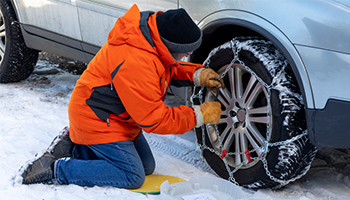The winter season is approaching and that means fun holiday travel and scenic trips to snowcapped mountains to look forward to. However, it also brings the possibility of bad weather and having to navigate driving through it for long-distance trips or getting to work or school locally. Whether it’s slick roads from heavy rain, icy bridges, or reduced visibility due to snow or fog, driving in winter weather can be dangerous. According to the U.S. Department of Transportation, about 21% of vehicle crashes involve hazardous weather.
Here are some tips to help you prepare and drive safely through rough storms and other seasonal weather.
1. Winterize Your Vehicle
The first step in safe winter driving is to make sure your car is winter-ready. This includes replacing wiper blades if needed, adding winter-formulated wiper fluid, and making sure you’re heater/defroster and major mechanical systems are in good working order. Make sure you have ice scrapers ready to go, and of course the right tires — more on that below.
2. Snow Tires and Chains
What kind of tires you need depends on your location and where you drive. All-season tires offer year-round performance for moderate climates that don’t encounter extreme snow and ice. However, for winter conditions, snow tires perform best. They have tread that remains more flexible to grip the road and tread patterns to channel and whisk away snow, slush, and water.

If you only face inclement conditions occasionally, say a once-a-year ski trip, then chains are another option. They are inexpensive and you only install them when needed. The downsides are 1) installing them in the middle of a snowstorm or at night can be a bear and 2) you must drive at very low speeds with chains on to avoid damaging your car. If you go this route, be sure to practice putting the chains on before you hit the road.
3. Keep an Emergency Kit
We know, it sounds basic, but it is a good idea to have certain supplies on hand when you are driving in wintry weather. Here’s a suggested list:
- Flashlight with extra batteries
- Gloves to keep your hands warm and dry when cleaning off your car or installing chains
- Towels or rags (especially if you don’t have gloves!)
- Shovel and/or Brush or Broom to remove snow on or around your vehicle
- Spare key
- Sand or kitty litter to provide traction if you get stuck in mud or snow
- Blankets, extra warm clothing, water and snacks
4. Check Conditions and Anticipate Delays

When bad weather hits, usually traffic delays come along with it. It’s always a good idea to check conditions ahead of time on your favorite weather app to know what’s in store. You can also follow groups like CalTrans in CA on social media for the latest on local conditions and road closures. One more tip: always set out with a full tank of gas, and don’t let your tank get too low in case you get stuck in a traffic jam for hours, it happens.
5. Don’t Underestimate Rain or Black Ice
Surprisingly, rainy conditions can be just as treacherous as snow and ice. Visibility is reduced and built-up oil on the roads causes them to become slick. Hydroplaning is common in the rain, especially during the first few minutes of rain. Hydroplaning is when there’s too much water on the road and your car’s tires lose contact with the road. Similarly, black ice is a hazard because it’s hard to detect. Whether it’s heavy rain, or wet, possibly frozen roads, remember to slow down, these are dangerous conditions.
6. Eliminate distractions
Anytime you are driving in poor conditions, it’s important to keep your focus on the road. Before you hit the road, plan out your route so you’re not as reliant on mapping apps and let others know your route and estimated arrival time. While you want to stay connected, it’s safer to not look over at directions or try to notify others while your attention to the road ahead is needed.
7. Be on the Lookout for Unexpected Hazards

Visibility is often compromised during bad weather. Be extra observant of the road ahead, looking out for unexpected hazards such as snowplows, maintenance trucks, or emergency vehicles. Also keep an eye out for other cars that may be going slow or be pulled onto the shoulder, as well as debris such as branches or items the wind may have blown into the road.
8. Use These Bad Weather Driving Tactics
There are many things you can’t control around bad weather, but you can control how you operate your vehicle. Here are some tips for driving in winter weather:
- Drive slowly and adjust speed down if you encounter rain, snow, or ice
- Accelerate and decelerate slowly to avoid skidding
- Don’t stop if you can avoid it — a continuous slow speed is better than stopping and starting which can cause the car to fishtail
- Don’t stop going when on a hill — it’s hard to get moving on an icy uphill road, try to enter the hill with some momentum and keep moving at a slow pace, not stopping unless you must
9. Stay Home

Sometimes, if your trip isn’t mandatory, your best bet is to postpone it and stay home. Fewer cars on the road make it safer for those who are, and easier for plows to clear roadways. This may be easier said than done, but it’s worth thinking about as an option before you head out into inclement weather.
10. Proper Insurance
Since more accidents happen in bad weather, it’s an important time to make sure your auto insurance coverage is adequate and in force. In addition to your state’s minimum liability protection, if an accident occurs, you’ll be relieved if you have collision and comprehensive insurance, which cover accidents and some other types of damage to your vehicle. It’s always a good idea to have uninsured/underinsured motorist coverage and higher liability limits as well.
At AIS Insurance, we’ve been around for over 50 years advising people on how much coverage they need. We partner with highly-rated insurance providers and always look for the best combination of price and coverage. Give our specialists a call at 888-963-4247 for a free quote, we’re standing by to help.
The information in this article is obtained from various sources and offered for educational purposes only. Furthermore, it should not replace the advice of a qualified professional. The definitions, terms, and coverage in a given policy may be different than those suggested here. No warranty or appropriateness for a specific purpose is expressed or implied.

